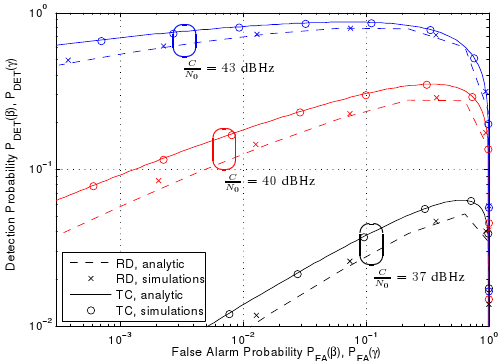A Comparison Between Ratio Detection and Threshold Comparison for GNSS Acquisition
- Published
- Thu, Mar 01, 2012
- Tags
- rotm
- Contact

In this work, a comparison between two widespread global navigation satellite system acquisition strategies is presented. The first strategy bases (TC) its decision on comparing the energy within a cell of the partitioned search space to a threshold, while the second one uses the ratio between the two largest cell energies (RD). It is shown that the TC outperforms RD in terms of receiver operating characteristics in many practically relevant cases. Moreover, despite the purported simplicity of the ratio detection method, it is further shown that its complexity is comparable to or even higher than the one of threshold comparison with adaptive threshold setting.
The figure shows the receiver operating characteristics (i.e., detection probability as a function of the false alarm probability) for different values of the carrier-to-noise-PSD ratio. The search space consists of 17 possible Doppler frequencies with each 2046 possible code phases. One can easily see that TC outperforms RD in most cases.
More detailed information can be found in our paper (to appear in the April issue of IEEE Trans. Aerosp. Electron. Syst.).
Browse the Results of the Month archive.
